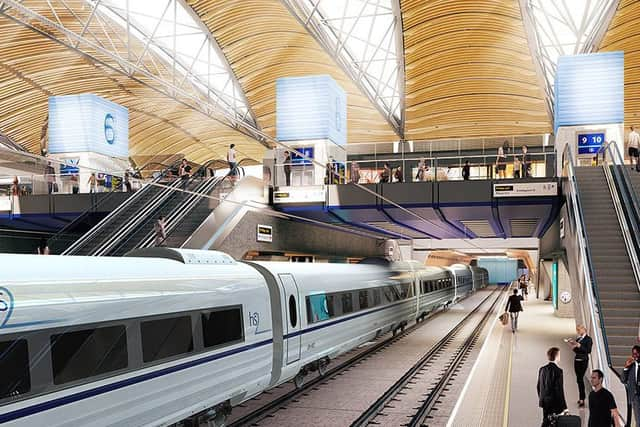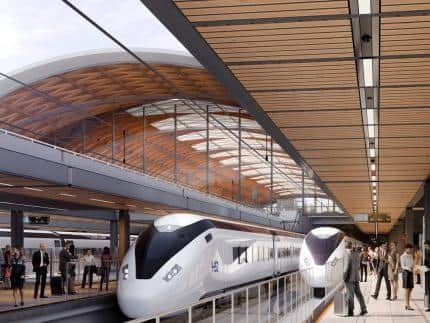HS2 will 'radically improve' rail services from Milton Keynes, says professional rail planner
and live on Freeview channel 276
That's the view of professional rail planner William Barter, who has been working with HS2 bosses to explain the multi million pound scheme to the public.
This week HS2 released a video describing how the new railway, where trains will travel at 250mph, will be a "game-changer" for the rail network.
Advertisement
Advertisement
"Building HS2 frees up a massive amount of space on the existing railway by placing high speed services on their own pair of tracks. Once HS2 is operating, services can run much closer together, there will be space for future growth in passenger numbers and more freight can travel by rail," says the company, which is owned by the Department for Transport.
With the 345 miles of new HS2 track, journey times will be slashed and, once complete, it could treble the number of passengers between London, Birmingham, Manchester and Leeds.
Mr Barter lives just outside MK and is a regular user of Milton Keynes station.
He says non-stop trains removed from the line through Milton Keynes onto HS2 will be replaced by trains that do stop, and this will radically improve local and regional services for both London commuters and commuters into Milton Keynes.
Advertisement
Advertisement
His article, called Why Milton Keynes needs HS2 , is published below:


'Between 1997 and 2014, Milton Keynes and Northampton stations saw 120 per cent passenger growth – well above the regional average. There are few commuter services for Milton Keynes without standing passengers and it’s not unusual for rail users to go without a seat for the best part of an hour on their way to or from work – something I have experienced myself as a resident of South Northamptonshire and a frequent traveller from Milton Keynes Central.
The 17:46 service from London Euston, first stop Milton Keynes, was revealed to be the UK’s most crowded commuter train last year, with more than half of its passengers having to stand.
And demand will grow. Not only is Milton Keynes expected to expand by 50,000 to 300,000 by 2025 – becoming a city bigger than Newcastle – while housing growth in the wider area the station serves, in towns such as Buckingham and Towcester, continues apace. With passenger numbers on London Northwestern Railway services forecast to rise as a result by almost two per cent annually, drastic action is needed to provide rail capacity for our town as travel returns to anything like normal post-Covid-19.
Advertisement
Advertisement
The problem is that our current rail network has to accommodate fast and slow, non-stop and stopping trains on the same lines. It is trying to do too many jobs, and can’t do all of them fully. This means that we can’t get the most out of existing routes, as most trains on the line do not serve our stations. Trying to fit all sorts of trains on the same railway has created a network that is overcrowded, unreliable and congested. The train operators and Network Rail have done their best to add more seats to the service, but ‘patch and mend’ won’t do for ever.


The only lasting solution to the problem is to build another pair of tracks out of Euston to the North, and that’s what High Speed 2 (HS2) is. Now under construction, HS2 will initially link Birmingham and London, with its trains running further North to Manchester, Liverpool and Scotland on the existing network. Ultimately, it will expand into a Y-shaped network of new infrastructure to Manchester in the West and Leeds in the East.
But how can Britain’s new high-speed railway, that doesn’t even stop in Milton Keynes, help solve our transport issues and transform the railway across Britain? HS2 unlocks a massive amount of space on the existing railway by giving the long distance services their own pair of tracks. Once HS2 is operating, those long distance services that currently fly through Milton Keynes, Bletchley and Wolverton can be replaced with new trains that serve local and regional needs. For instance, technical modelling shows that once the non-stop trains are on HS2, there could be five more trains in the morning peak hour from Milton Keynes to London Euston compared to the May 2019 timetable, two of which would be ‘fast’ services.
For the homeward journey, introducing extra train services would decrease the crowding on services to Milton Keynes leaving London between 5pm and 6pm, on which load factors were 115 per cent in 2015. Building HS2 could provide London Euston with 11,300 peak-time commuter seats compared with 6,400 seats in 2017 – a 76 per cent increase for Milton Keynes passengers travelling home. Forecasts suggest that immediately only 81 per cent of the seats would be needed, so flexibility would be available to meet growing rail demands in the future. Without this boost to capacity on the West Coast Main Line – the busiest mixed-use railway in Europe – predictions indicate that crowding will be untenable. If Covid-19 has a long term effect on travelling habits, it will be that sardine-can conditions become unacceptable for safety reasons.
Advertisement
Advertisement
And there is more to HS2 than just high speed for long distance travellers and capacity for commuters. Milton Keynes is not just a commuter town but a major centre of employment in its own right. The recent Oakervee review into HS2 commissioned by the Government states that connectivity could be improved between Milton Keynes, the West Midlands and the North of England, as well as the forthcoming link to East West Rail. This paves the way for faster and more frequent services for commuters into Milton Keynes, supporting the town’s own prosperity and role as a regional transport hub.
HS2 will also relieve congestion on Milton Keynes’s surrounding road network as more freight could be handled on the existing rail network. These freight trains could serve the new Northampton Gateway Strategic Rail Freight Interchange, which will support around 7,000 jobs once fully operational, as well as the existing terminal in Daventry.
More freight on the rails is better for the environment too, as rail produces 76 per cent less carbon dioxide emissions than the equivalent road journey. As we move towards a low carbon economy, HS2 will help reduce carbon emissions, improve air quality and make our motorways safer.
Critics argue that the capacity crunch can be solved by simply adding more tracks to existing routes, but to see how difficult that would be you need only to look out of the window on your journey out of Euston as your train passes through Watford, Berkhamsted and Leighton Buzzard. Many of us remember the disruption when the West Coast Main Line was last ‘upgraded’ – further upgrades to our current lines would deliver a fraction of the capacity of a new railway route. And whereas speed on existing lines will always be limited by curves and tunnels, building a new route gives potential to reduce journey times through improved train speeds, competing better with air from the outset.
Advertisement
Advertisement
Not only will 345 miles of high-speed railway form the new backbone of our rail network, but freed of fast through trains, the lines we already have will be better able to serve the communities along them. HS2 is a once-in-a-generation opportunity to transform rail travel in the UK for generations to come.'